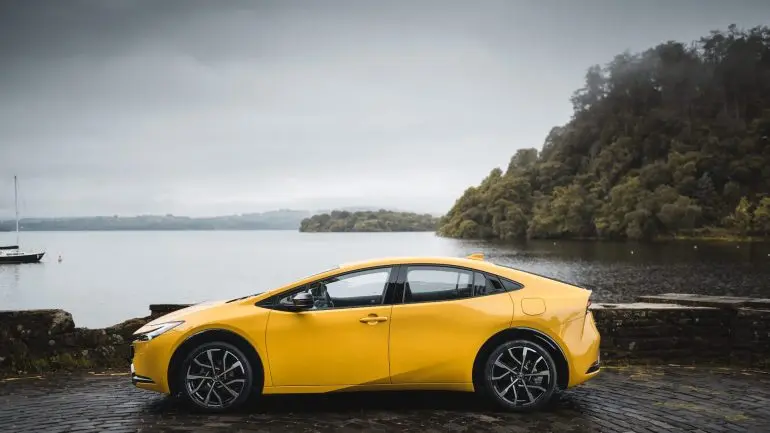It has the looks and the economy but will the new-to-Britain plug-in hybrid Prius prove to be popular too?

To even call this car a Prius seems odd, so very different is the new generation model to the original from the 1990s. Far larger, way more powerful and, a word no-one has surely ever called it before, gorgeous.
In the present line-up, perhaps only the Mirai is more of a looker than the new-to-Britain Prius plug-in hybrid, though the Corolla runs it close. The UK took its time to receive the present generation, and it’s only sold here as a PHEV. The same applies to other regional markets though cars have been available in some LHD European countries since 2023.
Big in Japan, built in Japan
Toyota’s homeland and the USA remain the car’s best markets, year to date sales being close to 75,000 and 40,000 units respectively. Those numbers include the 1.8- and 2.0-litre series hybrids as well as the 2.0-litre plug-in hybrid. The PHEV is front-wheel drive but in some countries there is also electric traction to the back axle for certain hybrid variants.
Britain will never be a major destination for exports yet the new car is clearly considered a worthwhile additional model for TGB’s dealers. Our cars come from Tsutsumi in Aichi prefecture, that plant being a major production base for various GA-C platform vehicles.
One of the most unusual changes which came with the fifth generation model was a rethink for the packaging. Which is likely why the car was initially rejected by Toyota Great Britain, generation three having been a favourite of taxi operators. Why? The huge boot, faultless reliability and excellent economy. Generation four did well for a time but faded towards the end of its life cycle.
Bigger boot but still small
For generation five, the wheelbase was stretched by 50 millimetres to 2,750 but the overall length went down by 46 mm to 4,599. So too it would seem with boot volume though that’s not the case. Luggage capacity is just 284 litres but in the prior model it was a mere 251. Which is why we tend to see Corolla estates being the preference of those who run a taxi business. Generation three was the one with the massive load space.
The powertrain is unusual for the motor having a higher output than the engine, these being 120 kW (163 PS) and 112 kW (152 PS). Combined power is 164 KW (223 PS), a whopping 90 more kilowatts than the previous PHEV Prius. TGB does not quote a net torque number but as with power, the motor (208 Nm) produces more than the engine (190 Nm).
There is also a decent range in EV mode too (officially up to 53 miles), thanks to relatively low weight of 1,545-1,610 kilos and a 13.6 kWh net battery (previous model: 8.8 kWh). WLTP emissions are just 12 g/km.
As with every Prius since the original, an electronically-controlled CVT is the only transmission and this one is the best yet. You really would be hard pressed to find any fault with it. The 2.0-litre engine, which isn’t turbocharged, is also near-silent and super-smooth.
Keen dynamics aided by low stance
Of torque steer there is none and handling is surely the best of any Prius yet, aided by a low centre of gravity and better front-to-rear weight distribution. Even though the architecture was carried over, Toyota shifted the fuel tank forward and down, while the battery is below the back seat. The car itself is also 50 mm closer to the road than the old model.
I’m not usually a great fan of one-pedal driving yet this car’s paddles do a terrific job of slowing progress very smoothly indeed. That’s helped by offering three settings, termed gentle, medium and strong. Acceleration is impressive too: the PHEV will reach 62 mph in only 6.8 seconds. It really does require an open mind in so many ways to accept that this is a Toyota Prius.
Eyes-On-Road system not perfect
Would the steering benefit from having a little more feel? Yes it would but at least there is a thick-of-rim wheel which is only 350 mm in diameter. If you prefer it to be low, as I do, the driver monitoring system often gets upset, which is annoying.
The endless chastising of SIT UP (not even please) and DRIVER’S FACE NOT RECOGNISED flashing away becomes tiresome. Worse, it pops up where the speedometer usually is so it catches the eye. Then it suddenly goes away only to return at seemingly random moments.
Maybe an OTA update is coming to remedy the far from polite (and very un-Japanese) Driver Monitor? The same issue was present in an LBX which I recently drove, though at least the Lexus system wasn’t as insistent.
Almost everything else inside the Prius is pleasing. That includes the look and feel of the plastics, abundance of real switches and dials, plentiful stowage spaces and general roominess. Having said that, even though seating positions are all fairly low, the tallest of drivers and occupants may find the windowsills to be on the high side.
Conclusion
This is assuredly the best Prius Toyota has given us thanks to its mix of style, speed, silence and economy.
Source from Just Auto
Disclaimer: The information set forth above is provided by just-auto.com independently of Alibaba.com. Alibaba.com makes no representation and warranties as to the quality and reliability of the seller and products. Alibaba.com expressly disclaims any liability for breaches pertaining to the copyright of content.




